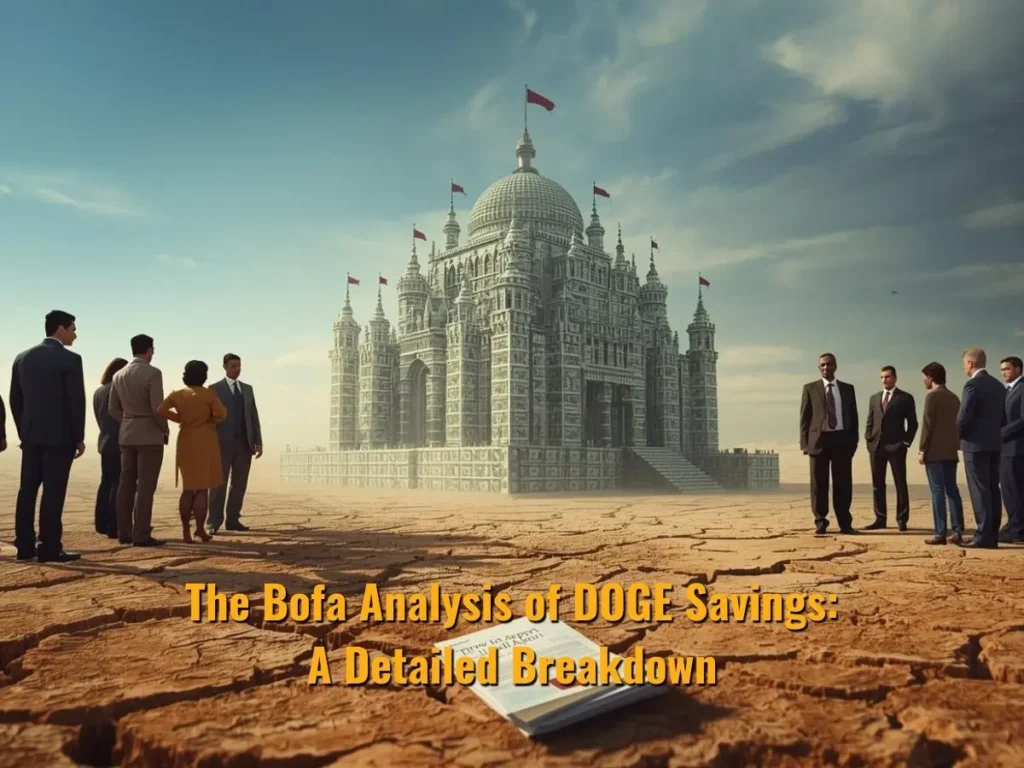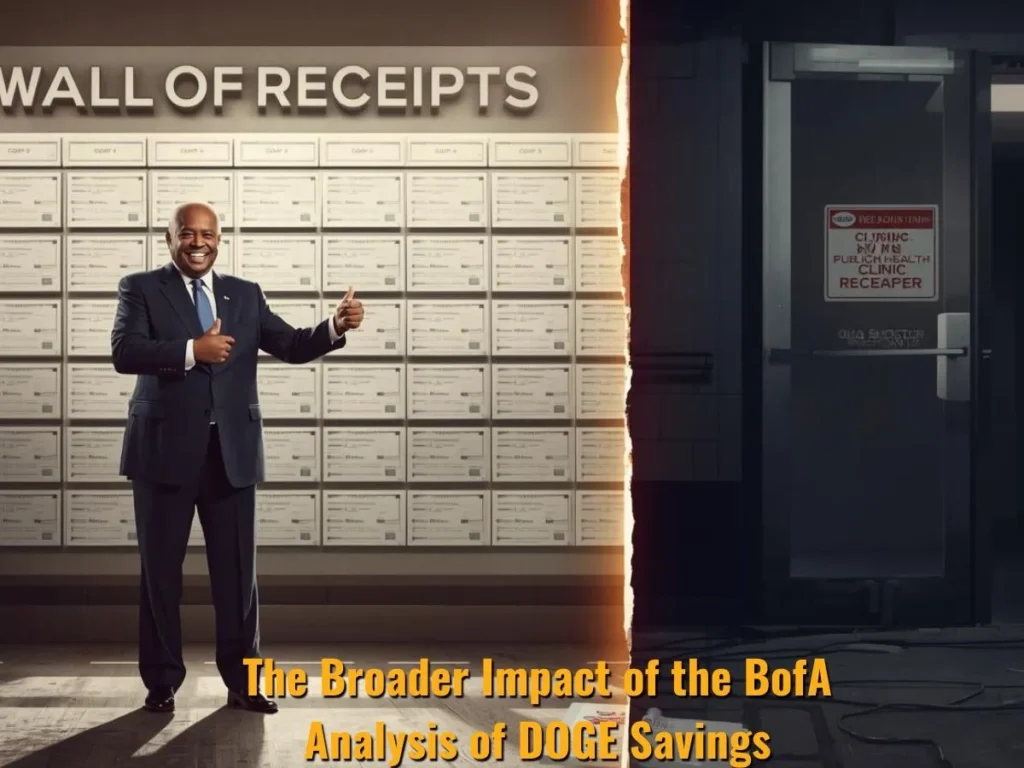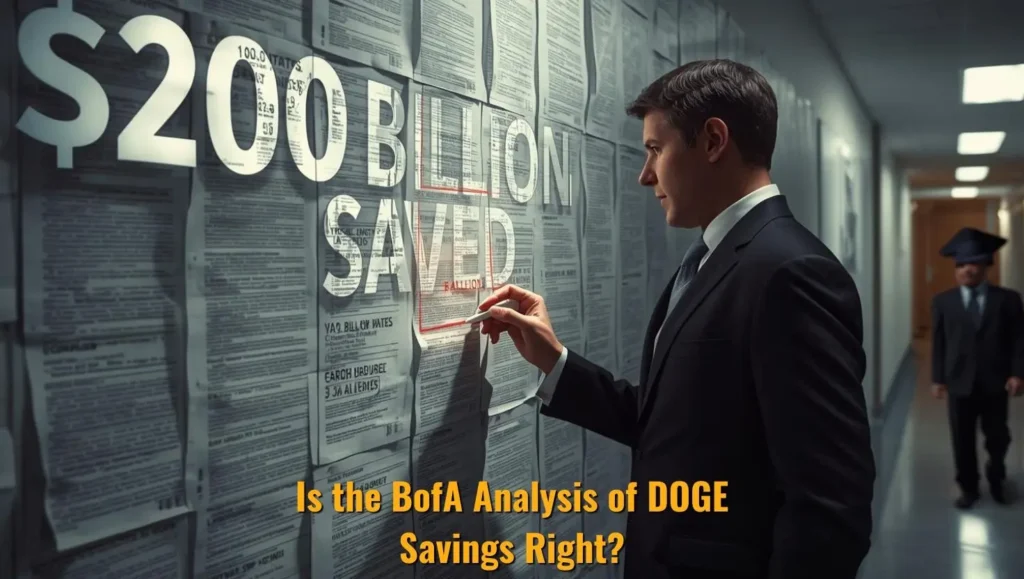Introduction
The BofA analysis of Doge savings tells a problematically different story from what the official narrative suggests.
Launched by Elon Musk, the Department of Government Efficiency (DOGE) promised to eliminate wasteful spending at the federal level.
The project proudly displays the so-called “Wall of Receipts,” claiming to have saved the government hundreds of billions of dollars; but are these savings real or merely an illusion in statistics?
This highly impactful report by Bank of America Global Research also directly contests those claims.
For taxpayers and policymakers, the central question is: Does this financial assessment truly reflect reality? We shall examine this critical divergence.
The Bofa Analysis of DOGE Savings: A Detailed Breakdown

Bank of America’s report goes beyond just headlines and claims that often contain a lot of bluster; it instead investigates numbers coldly with a financial lens.
The report from the investigative lights proves that alleged federal spending cuts are not actual. A distinction that drives the dagger through the heart of the official accounts.
They differ in the methodology of famine that the DOGE initiative accounts for the total value of contracts whose cancellation ceiling is the maximum value, with respect to those that were actual fund expenditure in the BofA analysis of DOGE savings.
The BofA report only looks at money spent. The semantics linking the bogus savings claims to the actual ones indicate a significant shift from one triumph to deep skepticism.
The BofA analysis further suggests that the majority of expenditure savings claimed by the government do not constitute any real reductions in the federal deficit. They are simply unspent funds.
The agency can reallocate such money to other projects. Moreover, the BofA analysis presents this critical viewpoint, as it shows that cuts do not always equate to cost-cutting in government or a reduction in national debt.
Why the BofA Analysis of DOGE Savings Differs from Official Claims
To truly understand the source of the controversy, one must also distinguish between “ceiling value” and “realized savings.”
A simple example is that if you close a credit card with a $10,000 limit that you never used, you have not “saved” $10,000. You have simply avoided an expense in the future.
This is precisely the application of such questionable accounting that the BofA analysis of DOGE savings employs.
The “Wall of Receipts” of DOGE often includes the total potential value of multi-year contracts that have been canceled, rather than the amounts yet to be spent.
While the practice is not illegal, it is nonetheless misleading. It expands the savings numbers to suggest success on a scale that may be somewhat inflated.
Many of the actual “cuts” were from contracts that were already coming to an end. The DOGE initiative essentially took credit for something that was already planned.
This adds to the inflated numbers. This is among the primary criticisms in the doge savings analysis. This is also one of the main reasons independent experts regard it so skeptically.
The Broader Impact of the BofA Analysis of DOGE Savings

What BofA says about DOGE savings does not stop at the numbers. The criticism of how DOGE went about creating its figures has raised questions about the transparency of the government.
Where citizens must live under public initiatives they don’t trust, they lose confidence in those public institutions. On the contrary, the report also reveals the reality of cuts, which people frequently ignore when competing to claim the upper hand.
Some contracts may have been wasteful; however, others were for vital services like:
- Migrant shelters
- Public health initiatives
- Scientific research
The impersonal nature of contract termination comes with a human cost that directly affects the employees of federal contractors and the communities they serve.
The BofA analysis of Doge savings also treats the macroeconomic ambiance. The alleged savings were intended to offset the national debt, but due to inter-agency reallocation of funds, there are no net savings in government expenditure.
This cloudy picture is actually built upon the façade of the federal budget. In this case, the administration can boast fiscal prudence amid a period of high spending.
Conclusion
The bofa analysis of doge savings is a vital check on government claims. Although the DOGE drive has actually terminated some of the contracts, the demonstration of the savings is only a small one.
This is not just about counting differently; it is, in fact, a blatant misrepresentation of everything intended to convert a questionable program into a success.
The BofA report and similar independent analyses provide a much-needed injection of reality. A government that is truly efficient demands genuine transparency and accurate presentation.
FAQs
What is the BofA analysis of DOGE savings?
The Bank of America analysis of DOGE savings is actually a report from Bank of America Global Research on reported savings from the Department of Government Efficiency (DOGE), which is said to have not been applied to a certain calculation of inflated amounts.
Is the DOGE savings report accurate?
Not Accurate: the official DOGE savings report counts potential “ceiling values” rather than real, actual savings that has been disputed by independent analyses.
How much did DOGE save the government?
The argument for actual savings is strenuously contested, with independent financial analyses saying the amounts of real, verifiable savings were just a small fraction of the billions the DOGE initiative claimed.
What is the Department of Government Efficiency (DOGE)?
Department of Government Efficiency-Efficiency, commonly called DOGE, is a Trump initiative headed by Musk to identify and eliminate unnecessary federal government spending.
Why is the DOGE savings report controversial?
The DOGE savings report is controversial because its claims of massive savings are based on a misleading accounting methodology that counts potential, not actual, savings, a fact highlighted by the Bank of America analysis.




